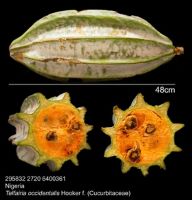Content is from Kirkbride et al. 2006Kirkbride et al. 2006:
Kirkbride JH, Jr, Gunn CR, and Dallwitz MJ. 2006. Family guide for fruits and seeds, vers. 1.0. Accessed September 2020-January 2022. URL: https://nt.ars-grin.gov/seedsfruits/keys/frsdfam/index.cfm ., without modification.
Updates are forthcoming.
Cones: Fleshyfleshy:
texture—fairly firm and dense, juicy or at least moist, and easily cut
; spermidium when fleshyfleshy:
texture—fairly firm and dense, juicy or at least moist, and easily cut
(Spjut Fig. 50F & only family). Fruiting scales absent. Fruiting bracts absent.
Seeds: Arilaril:
(broad sense) appendicular structure that wholly or partly envelops a seed and is produced from or a modification of the funicle, raphe, or outer integument; usually fleshy or pulpy, sometimes spongy or tufted-capillate, often brightly colored absent. Seed minute; circularcircular:
absent. Seed minute; circularcircular:
(of embryo) linear embryo is curved into an "O" shape ; in transectiontransection:
; in transectiontransection:
a cross section; representing a plane made by cutting across an organ at a right angle to its length tereteterete:
tereteterete:
approximately circular in cross section; width and thickness approximately equal
 ; not bowl shaped; not nutlike; without winglike beakbeak:
; not bowl shaped; not nutlike; without winglike beakbeak:
a usually firm, terminal appendage, sometimes tapered ; without caudatecaudate:
; without caudatecaudate:
tapering to a long, tail-like appendage appendage(s); without canavanine. Sarcotestasarcotesta:
appendage(s); without canavanine. Sarcotestasarcotesta:
pulpy or fleshy outer layer of the seed coat, simulates aril present (sarcotesta-like); fleshyfleshy:
present (sarcotesta-like); fleshyfleshy:
texture—fairly firm and dense, juicy or at least moist, and easily cut
. Testatesta:
seed coat
 present; with fleshyfleshy:
present; with fleshyfleshy:
texture—fairly firm and dense, juicy or at least moist, and easily cut
or leatheryleathery:
texture—moderately thick, tough, and very pliable
layer over hard layer (with watery layer below); tight; surface unsmooth; surface with merged raised features; surface wrinkledwrinkled:
surface relief—shallow, irregular folds and furrows covering the surface; appearing overall though crumpled and then spread out ; without crease or line separating cotyledons from hypocotyl-radicle; without notch along margin where cotyledons from hypocotyl-radicle tip approach each other; without glands; without bristles; glabrousglabrous:
; without crease or line separating cotyledons from hypocotyl-radicle; without notch along margin where cotyledons from hypocotyl-radicle tip approach each other; without glands; without bristles; glabrousglabrous:
without hairs
; without wings; without collar; without operculumoperculum:
a dehiscent cap (or lid) of a seed or fruit that opens during germination or dehiscence
 ; colored; monochrome; orange to yellow; fleshyfleshy:
; colored; monochrome; orange to yellow; fleshyfleshy:
texture—fairly firm and dense, juicy or at least moist, and easily cut
or bonybony:
very hard and rather brittle, like bone
layers; not becoming mucilaginousmucilaginous:
resembling mucilage; moist and sticky
when wetted. Embryo differentiated from food reserve; well developed; 1 per seed; 0.3–0.5 times the length of food reserve; at one end of seed not extending into a depression or cup; linearlinear:
(shape) long, narrow, and uniform in width; (of embryo) embryo is straight and much longer than wide ; straight; parallel to seed length; without coleorhiza; without simmondsin; without stomata; not green; with 2 or more cotyledons. Cotyledons 2; well developed; 0.7 times length of embryo; 1 times wider than hypocotyl-radicle; smooth; with apicesapex:
; straight; parallel to seed length; without coleorhiza; without simmondsin; without stomata; not green; with 2 or more cotyledons. Cotyledons 2; well developed; 0.7 times length of embryo; 1 times wider than hypocotyl-radicle; smooth; with apicesapex:
the point farthest from the point of attachment, or the "tip" of an organ entire; equal in size; not punctatepunctate:
entire; equal in size; not punctatepunctate:
surface relief—dotted with pits or with translucent, sunken glands or with colored dots, similar to pitted dotted.
dotted.
General references: Gunn, C.R., J.H. Wiersema, C.A. Ritchie, & J.H. Kirkbride, Jr. 1992 & amendments. Families and genera of Spermatophytes recognized by the Agricultural Research Service. Techn. Bull. U.S.D.A. 1796:1–500, Page, C.N. 1990. Coniferophytina (Conifers and Ginkgoids). In: Kubitzki, K., ed., The families and genera of vascular plants, pp. 282–361. Springer-Verlag, Berlin, Mabberley, D.J. 1987. The plant-book, 706 p. Cambridge University Press, Cambridge, Martin, A.C. 1946. The comparative internal morphology of seeds. Amer. Midl. Naturalist 36:513–660, Schopmeyer, C.S. 1974. Seeds of Woodywoody:
texture—consisting mainly of indurate lignified tissues, characteristic of or resembling wood
plants in the United States. Agric. Handb. 450:1–883, and Spjut, R.W. 1994. A systematic treatment of fruit types. Mem. New York Bot. Gard. 70:1–182.